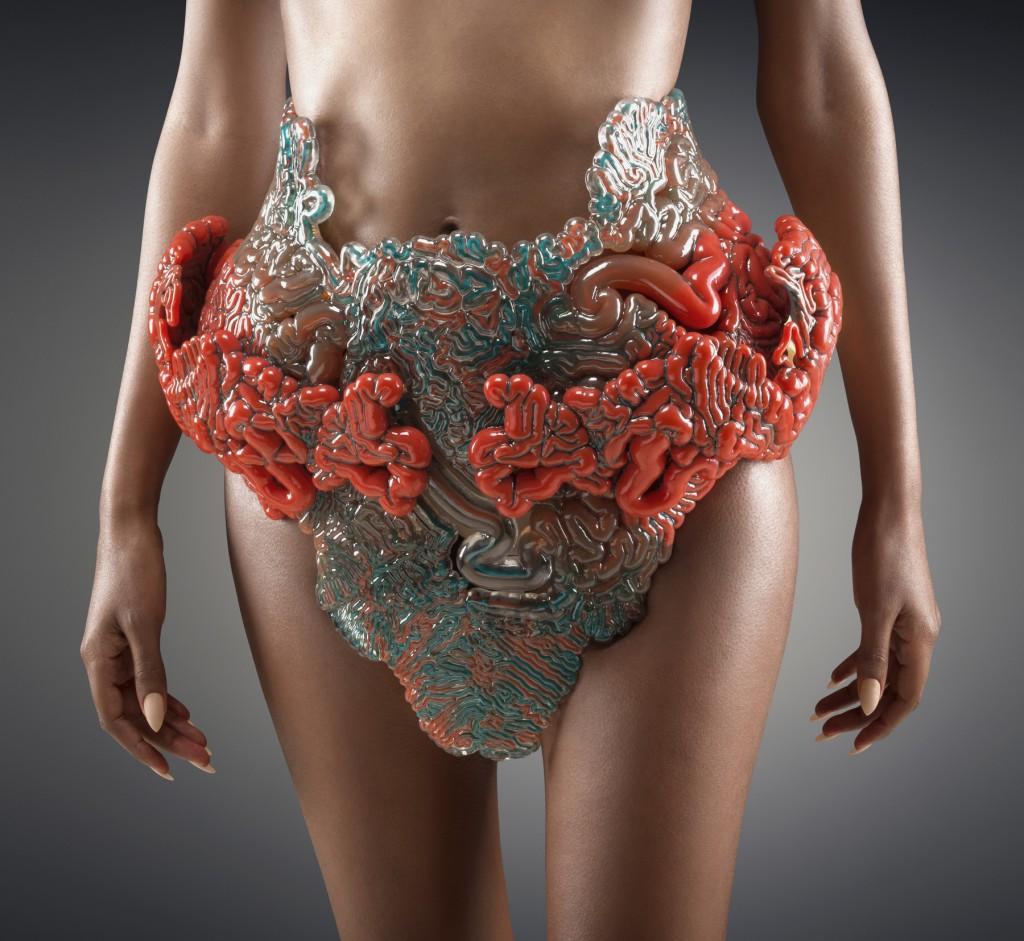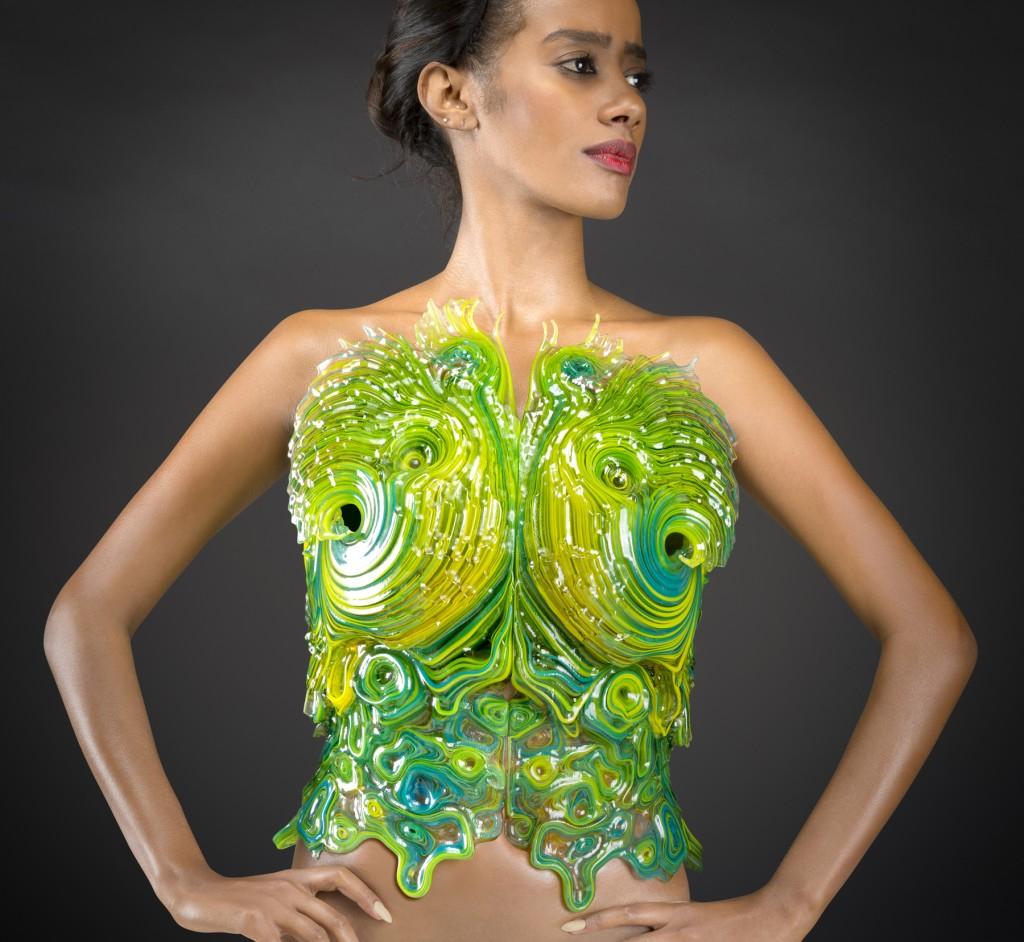Neri Oxman & Team Utilize Stratasys’ Triple-Jetting Technology to Create “Wearable Skins” with Stellar Inspiration

Neri Oxman. (Photo by Tom Allen)
Neri Oxman is an architect, professor, and designer with an impressive CV. She directs the Mediated Matter design research group at MIT Media Lab, where her group researches and applies knowledge in various fields to comprehensive product and architectural design. She has won a fairly staggering amount of awards for her work and has exhibited her works in museums across the world. She has works in the permanent collections of New York City’s MOMA and Paris’ Centre Georges Pompidou Museum, as well as having exhibited in other museums and private collections around the world. At MIT, she even designed her own research area , coining the phrase “Material Ecology” to describe it.
This impressive figure has now teamed up with an impressive figure in the 3D printing world. Oxman and her team utilized Stratasys’ 3D printing technology to bring their latest designs to life — and they’ve just been unveiled at EuroMold, which is running November 25-28. Stratasys’ “The Sixth Element: Exploring the  Natural Beauty of 3D Printing” collection is on display this week in Frankfurt. EuroMold Visitors can see four “wearable skins” based on stellar inspiration at Hall 11, Booth FN01.
Natural Beauty of 3D Printing” collection is on display this week in Frankfurt. EuroMold Visitors can see four “wearable skins” based on stellar inspiration at Hall 11, Booth FN01.
Oxman’s project itself is titled “Wanderers: An Astrobiological Exploration,” and is a collaboration between members of her Mediated Matter team and Christoph Bader and Dominik Kolb of deskriptiv. Bader and Kolb are a Germany-based design duo who bring together computer sciences and visual arts, focusing on a process- rather than product-oriented process.
The collection currently features four of these wearable skins, each inspired by different parts of the cosmos and human anatomy and biology. This project highlights Stratasys’ triple-jetting 3D printing ability to bring together the natural with the latest technology. Not only are these pieces created using multi-material 3D printing technology, but they are the first such pieces that aim to embed living matter.
“3D printing enables us to customize our designs and produce close to perfect-fit second skins informed by human CAT or MRI scans. The Stratasys triple-jetting technology of the Objet500 Connex3 color, multi-material 3D Production System offers designers unprecedented control over material properties such as rigidity, opacity and color at scales of just several microns. This enabled us to design for movement, as well as being able to implement spatially differentiated, layered channels, folds, pores and pockets. None of this would be possible with traditional fabrication methods,” says Oxman of her project.
Stratasys’ 3D printing technology was clearly vital to these organic designs. Because the wearables can be fitted directly to a specific individual, customization is complete from beginning to end in this process, enabling designers full control over the entire life of the project. Bringing together design, engineering, and the latest in technology, these wearables present “augmented extensions to our own bodies,” as Oxman puts it. The four designs in the collection are based on planetary bodies: Jupiter, Saturn, Mercury, and the Moon are represented as the inspirations for these pieces. Titles for the pieces are inspired the origins of the word “planet” — which comes from the Greek term planētēs meaning “wanderer.”
The pieces –MUSHTARI (مشتري): Jupiter’s Wanderer, ZUHAL (زحل): Saturn’s Wanderer, OTAARED (عطارد): Mercury’s Wanderer, and AL-QAMAR (قمر): Luna’s Wanderer — all focus on different aspects of the “wanderers.” For example, MUSHTARI (which means “huge” or “giant” in Arabic) is meant to interact with Jupiter’s atmosphere, with a design based on the human gastrointestinal tract, while OTAARED takes into account Mercury’s lack of atmosphere, providing a protective exoskeleton.
Likewise, 3D printing capabilities benefited each piece in different ways. Each used the multi-material 3D printing capabilities to enhance different aspects. For example, in ZUHAL, the size, density, and organization vary among the pieces of the textural exterior, enabled by the triple-jetting technology. AL-QAMAR, on the other hand, benefits from the triple-jetting technology in the different materials required: rubber and rigid, transparent and opaque, neutral and colored, and even standard type and bio-compatible material.
“With this collection,” explained Oxman, “we have designed spatially and materially complex wearables pointing towards the possibility of containing living matter that can interact with the environment. Each piece intends to hold life sustaining elements contained within 3D printed vascular structures with internal cavities, made possible with the dimensional stability and high-resolution accuracy of Stratasys’ 3D printing technology. Living matter within these structures will ultimately transform oxygen for breathing, photons for seeing, biomass for eating, biofuels for moving and calcium for building.”
Further work will be done on the collection, with the next stages of growth focusing on integrating living engineered cells into the pieces. The team strives for functional augmentation inspired by natural growth methods. Bader and Kolb’s computational growth process cultivates forms on the human body, drawing inspiration from growing and adapting seeds.
What do you think about this collection? Let us know your thoughts on the future of triple-jetting technology over at the Wearable Skins forum thread at 3DPB.com.
Subscribe to Our Email Newsletter
Stay up-to-date on all the latest news from the 3D printing industry and receive information and offers from third party vendors.
You May Also Like
3D Printing Unpeeled: New Arkema Material for HP, Saddle and Macro MEMS
A new Arkema material for MJF is said to reduce costs per part by up to 25% and have an 85% reusability ratio. HP 3D HR PA 12 S has been...
3D Printing News Briefs, January 20, 2024: FDM, LPBF, Underwater 3D Printer, Racing, & More
We’re starting off with a process certification in today’s 3D Printing News Briefs, and then moving on to research about solute trapping, laser powder bed fusion, and then moving on...
3D Printing Webinar and Event Roundup: December 3, 2023
We’ve got plenty of events and webinars coming up for you this week! Quickparts is having a Manufacturing Roadshow, America Makes is holding a Member Town Hall, Stratafest makes two...
Intuitive Machines Debuts $40M Hub for Lunar Ambitions and 3D Printing Tech
Best known for its pioneering work in lunar exploration and its development of the Nova-C lunar lander, Intuitive Machines (Nasdaq: LUNR) has marked yet another significant milestone. The leading space...




































